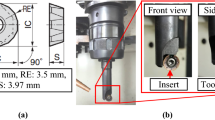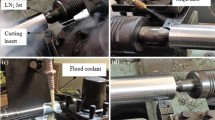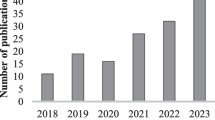Abstract
The requirement for utilization of safe lubricants is rising in all parts of the industry due to human and environmental concerns. Therefore, complete omission or replacement of the mineral-based cutting fluids by safer ones is deemed to be very important in today’s machining operations. In the present study, the effect of pre-cooling in cryogenic machining using liquid nitrogen was compared with dry machining. Tool temperature, workpiece surface quality and tool wear were studied as the output response parameters. The results showed that the tool temperature had no sensitivity to the cutting parameters when liquid nitrogen was employed. However, in dry machining as the cutting parameters (i.e., cutting speed and feed rate) increased, the cutting temperature rose. Pre-cooling by liquid nitrogen led to reduction of the tool temperature by 73–86% compared with the dry method. Also, surface quality in terms of defective zones such as adhered materials, removed regions, and scratch marks was evaluated. It was observed that many defects were formed on the workpiece surface in dry machining, whereas it was completely defect free in cryogenic machining. Concerning the tool wear, the SEM images of tool rake face showed that the tool wear under the mechanisms of adhesion and breakage was observed in a vast area of the tool surface in dry machining, enhancing the creation of defects on the workpiece surface.










Similar content being viewed by others
Abbreviations
- BUE:
-
Built-up edge
- BUL:
-
Built-up layer
- EDX:
-
Energy-dispersive X-ray spectroscopy
- V f :
-
Chip speed on tool rake face
- a w :
-
Chip width
- F c :
-
Cutting force
- r c :
-
Cutting ratio
- V c :
-
Cutting speed
- ρ :
-
Density of workpiece
- f :
-
Feed rate
- β :
-
Friction angle
- µ :
-
Friction coefficient
- F f :
-
Friction force
- P s :
-
Generated heat rate in primary deformation zone
- P f :
-
Generated heat rate in secondary deformation zone
- Φ c :
-
Heat transfer rate to the chip
- Φ t :
-
Heat transfer rate to the tool
- Φ w :
-
Heat transfer rate to the workpiece
- θ f :
-
Increased average temperature due to secondary deformation
- θ s :
-
Mean temperature of materials when crossing the primary deformation zone
- Γ :
-
Percentile of transferred heat to the workpiece
- P m :
-
Power consumption in cutting process
- α :
-
Rake angle
- C :
-
Special heat capacity of the workpiece
- a c :
-
Uncut chip thickness
References
Venugopal, K.; Paul, S.; Chattopadhyay, A.: Tool wear in cryogenic turning of Ti–6Al–4V alloy. Cryogenics 47(1), 12–18 (2007)
Jerold, B.D.; Kumar, M.P.: Experimental comparison of carbon-dioxide and liquid nitrogen cryogenic coolants in turning of AISI 1045 steel. Cryogenics 52(10), 569–574 (2012)
Atlati, S.; Haddag, B.; Nouari, M.; Moufki, A.: Effect of the local friction and contact nature on the built-up edge formation process in machining ductile metals. Tribol. Int. 90, 217–227 (2015)
Chen, L.; Tai, B.L.; Chaudhari, R.G.; Song, X.; Shih, A.J.: Machined surface temperature in hard turning. Int. J. Mach. Tools Manuf. 121, 10–21 (2017)
Huang, K.; Yang, W.: Analytical model of temperature field in workpiece machined surface layer in orthogonal cutting. J. Mater. Process. Technol. 229, 375–389 (2016)
Gómez-Parra, A.; Álvarez-Alcón, M.; Salguero, J.; Batista, M.; Marcos, M.: Analysis of the evolution of the built-up edge and built-up layer formation mechanisms in the dry turning of aeronautical aluminium alloys. Wear 302(1–2), 1209–1218 (2013)
Sarıkaya, M.; Yılmaz, V.; Güllü, A.: Analysis of cutting parameters and cooling/lubrication methods for sustainable machining in turning of Haynes 25 superalloy. J. Clean. Prod. 133, 172–181 (2016)
ManojKumar, K.; Ghosh, A.: Assessment of cooling-lubrication and wettability characteristics of nano-engineered sunflower oil as cutting fluid and its impact on SQCL grinding performance. J. Mater. Process. Technol. 237, 55–64 (2016)
Musavi, S.H.; Davoodi, B.; Niknam, S.A.: Environmental-friendly turning of A286 superalloy. J. Manuf. Process. 32, 734–743 (2018)
Musavi, S.H.; Davoodi, B.; Niknam, S.A.: Effects of reinforced nanoparticles with surfactant on surface quality and chip formation morphology in MQL-turning of superalloys. J. Manuf. Process. 40, 128–139 (2019)
Debnath, S.; Reddy, M.M.; Yi, Q.S.: Environmental friendly cutting fluids and cooling techniques in machining: a review. J. Clean. Prod. 83, 33–47 (2014)
Silva, L.R.; Corrêa, E.C.; Brandão, J.R.; de Ávila, R.F.: Environmentally friendly manufacturing: behavior analysis of minimum quantity of lubricant-MQL in grinding process. J. Clean. Prod. (2013). https://doi.org/10.1016/j.jclepro.2013.01.033
Naskar, A.; Chattopadhyay, A.: Investigation on flank wear mechanism of CVD and PVD hard coatings in high speed dry turning of low and high carbon steel. Wear 2017(396–397), 98–106 (2018)
Thakur, A.; Gangopadhyay, S.: Influence of tribological properties on the performance of uncoated, CVD and PVD coated tools in machining of Incoloy 825. Tribol. Int. 102, 198–212 (2016)
Suresh Kannan, I.; Ghosh, A.: Anti-friction and wetting behavior of a new polymer composite coating towards aluminium and dry machining of AA2024 alloy by coated end mills. J. Mater. Process. Technol. 252, 280–293 (2018)
Koyilada, B.; Gangopadhyay, S.; Thakur, A.: Comparative evaluation of machinability characteristics of Nimonic C-263 using CVD and PVD coated tools. Measurement 85, 152–163 (2016)
Kumar, C.S.; Patel, S.K.: Effect of WEDM surface texturing on Al2O3/TiCN composite ceramic tools in dry cutting of hardened steel. Ceram. Int. 44(2), 2510–2523 (2018)
Orra, K.; Choudhury, S.K.: Tribological aspects of various geometrically shaped micro-textures on cutting insert to improve tool life in hard turning process. J. Manuf. Process. 31, 502–513 (2018)
Vasumathy, D.; Meena, A.: Influence of micro scale textured tools on tribological properties at tool-chip interface in turning AISI 316 austenitic stainless steel. Wear 376, 1747–1758 (2017)
Kawasegi, N.; Ozaki, K.; Morita, N.; Nishimura, K.; Yamaguchi, M.: Development and machining performance of a textured diamond cutting tool fabricated with a focused ion beam and heat treatment. Precis. Eng. 47, 311–320 (2017)
Bagherzadeh, A.; Budak, E.: Investigation of machinability in turning of difficult-to-cut materials using a new cryogenic cooling approach. Tribol. Int. 119, 510–520 (2018)
Mulyana, T.; Rahim, E.A.; Yahaya, S.N.M.: The influence of cryogenic supercritical carbon dioxide cooling on tool wear during machining high thermal conductivity steel. J. Clean. Prod. 164, 950–962 (2017)
Sartori, S.; Ghiotti, A.; Bruschi, S.: Temperature effects on the Ti6Al4V machinability using cooled gaseous nitrogen in semi-finishing turning. J. Manuf. Process. 30, 187–194 (2017)
Pereira, O.; Rodríguez, A.; Fernández-Abia, A.; Barreiro, J.; de Lacalle, L.L.: Cryogenic and minimum quantity lubrication for an eco-efficiency turning of AISI 304. J. Clean. Prod. 139, 440–449 (2016)
Sartori, S.; Moro, L.; Ghiotti, A.; Bruschi, S.: On the tool wear mechanisms in dry and cryogenic turning additive manufactured titanium alloys. Tribol. Int. 105, 264–273 (2017)
Trent, E.M.; Wright, P.K.: Metal Cutting. Butterworth-Heinemann, Oxford (2000)
Cui, X.; Guo, J.: Effects of cutting parameters on tool temperatures in intermittent turning with the formation of serrated chip considered. Appl. Therm. Eng. 110, 1220–1229 (2017)
Kumar, C.S.; Patel, S.K.: Effect of chip sliding velocity and temperature on the wear behaviour of PVD AlCrN and AlTiN coated mixed alumina cutting tools during turning of hardened steel. Surf. Coat. Technol. 334, 509–525 (2018)
Shokrani, A.; Dhokia, V.; Newman, S.T.: Environmentally conscious machining of difficult-to-machine materials with regard to cutting fluids. Int. J. Mach. Tools Manuf 57, 83–101 (2012)
Ulutan, D.; Ozel, T.: Machining induced surface integrity in titanium and nickel alloys: a review. Int. J. Mach. Tools Manuf. 51(3), 250–280 (2011)
Martinez, I.; Tanaka, R.; Yamane, Y.; et al.: Wear mechanism of coated tools in the turning of ductile cast iron having wide range of tensile strength. Precis. Eng. 47, 46–53 (2017)
Musavi, S.H.; Davoodi, B.; Niknam, S.A.: Effects of reinforced nanofluid with nanoparticles on cutting tool wear morphology. J. Cent. South Univ. 26(5), 1050–1064 (2019)
Kümmel, J.; Gibmeier, J.; Müller, E.; Schneider, R.; Schulze, V.; Wanner, A.: Detailed analysis of microstructure of intentionally formed built-up edges for improving wear behaviour in dry metal cutting process of steel. Wear 311(1–2), 21–30 (2014)
Author information
Authors and Affiliations
Corresponding author
Rights and permissions
About this article
Cite this article
Musavi, S.H., Davoodi, B. & Eskandari, B. Pre-cooling Intensity Effects on Cooling Efficiency in Cryogenic Turning. Arab J Sci Eng 44, 10389–10396 (2019). https://doi.org/10.1007/s13369-019-04056-6
Received:
Accepted:
Published:
Issue Date:
DOI: https://doi.org/10.1007/s13369-019-04056-6




